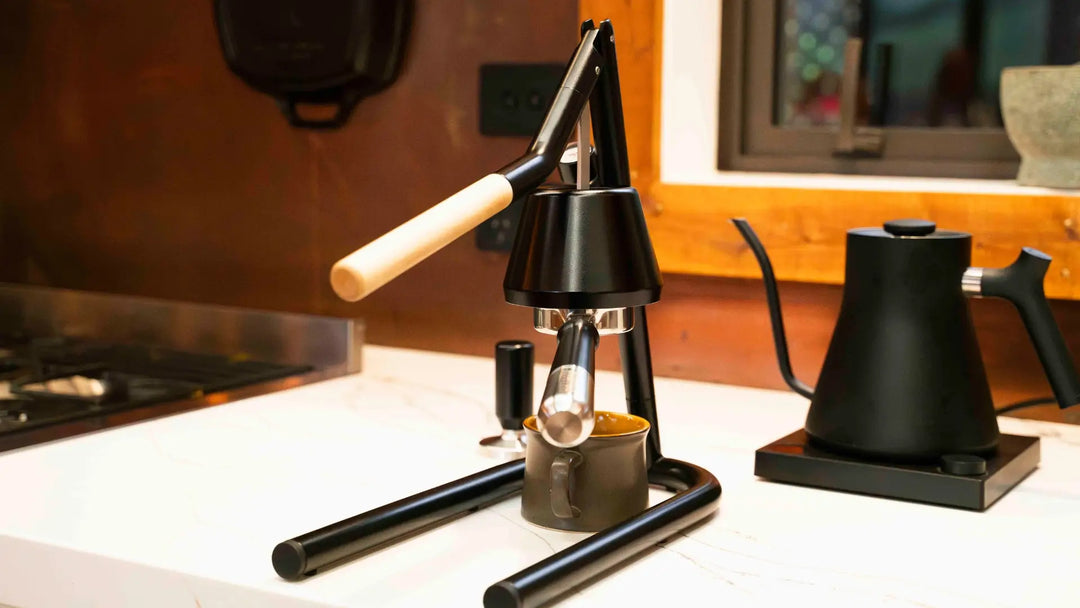The Espresso Puck Screen Debate: Essential or Optional?

Imagine carefully crafting your morning espresso, only to find its taste hindered by an uneven extraction or a dirty machine. In pursuit of the perfect shot, home baristas often encounter discussions about every tool and technique, including the much-debated espresso puck screen. These precision-enhancing accessories can be familiar territory for serious espresso enthusiasts, yet their necessity is still under debate!
The role of a puck screen—whether mesh type (see here), steel, or paper (see here)—is more significant than its modest appearance suggests. Designed to ensure even water distribution, prevent channeling, and refine flavour extraction, puck screens serve a clear purpose. However, they also raise a few questions, prompting discussions about their real importance versus good technique.
This article explores whether puck screens are essential or optional for the dedicated home barista. By examining their benefits, potential downsides, and cost considerations, we aim to help you decide if a puck screen should become a part of your espresso-making arsenal.
What is an Espresso Puck Screen?
As mentioned before, an espresso puck screen is a relatively new tool in the world of manual espresso brewing, designed to improve the quality and consistency of a shot of espresso. Developed to address common issues such as channeling and uneven extraction, puck screens have become an essential consideration for home baristas aiming to perfect their espresso brewing skills. They are particularly beneficial in manual and lever espresso machines, where precise control over variables is paramount. The concept is simple but effective: a puck screen is placed on top of the coffee grounds in the portafilter basket before brewing. As water flows through the espresso machine’s shower screen, the puck screen helps create another dispersion layer for even greater water distribution, leading to better extraction yields.
Definition and Purpose
The espresso puck screen is a thin, flat disc typically made of stainless steel. Its primary function is to assist in evenly distributing water across the coffee grounds during the brewing process. This uniform distribution is crucial in minimising channeling, which is when water finds an easier path through the coffee puck, leading to under-extracted or over-extracted shots. The use of a puck screen in manual espresso setups can contribute to a more consistent shot time and the extraction of coffee oils, enhancing the overall flavour profile of the espresso. By maintaining a steady and balanced flow, puck screens aid manual espresso users in achieving a “sweet spot” shot.

Varieties: Mesh, Steel, and Paper
Espresso puck screens come in various types, each suited for different brewing scenarios, but none are necessarily better than the other. Mesh filters, steel, and paper are the most common varieties, and each offers unique benefits that can enhance your espresso routine.
Mesh
Mesh puck screens, often made of stainless steel woven mesh, are popular for their durability and effectiveness in promoting even water flow. These screens are favoured by home baristas who regularly use manual espresso machines and like a reliable, reusable tool to assist in puck prep. Mesh types are adept at dispersing water across the coffee bed, ensuring that every inch of the coffee grounds is saturated evenly. This results in a consistently rich and balanced extraction.
Steel
Steel puck screens are robust, long-lasting and thinner than mesh variations, with the added benefit of offering more space between the shower screen and the puck, and being easy to clean. Usually laser-cut or photo-etched from a thin stainless steel plate, these screens provide a sturdy foundation for water distribution, reducing the occurrence of channeling and improving extraction yields. For those who use lever espresso machines, a steel puck screen can offer the ideal balance of pressure and flow needed for precise control over shot times.
Paper
Paper puck screens offer a disposable and often biodegradable option for espresso enthusiasts looking for fuss-free cleanup. While they may not offer the longevity of their mesh or steel counterparts, paper filters are excellent for those experimenting with grind size and puck prep. They provide a quick solution to improving the water flow and can be particularly beneficial in specialty coffee brewing, where the flavour profile can be sensitive to variables like water distribution and shot timing. Once used, the filter can be knocked straight into the knock box with the grind - no fishing around for it like with reusable screens.
Each type of puck screen brings unique advantages to the brewing process, allowing manual espresso users and home baristas to tailor their tools to their specific needs, whether focusing on ease of use, cleaning, or refining their brewing techniques.
Advantages of Using Puck Screens for Manual Espresso
Espresso brewing is an art, particularly when done manually at home. Home baristas often strive to replicate the quality of specialty coffee shops, and using a puck screen can significantly enhance your manual espresso-making process and the results you can achieve.
Promotes Even Water Distribution
If we haven't hammered this point home enough yet, we soon will. The crucial advantage of using a puck screen is its ability to promote even water distribution during espresso brewing! When water flows uniformly through the coffee bed, it results in a more balanced and consistent espresso extraction. This is particularly beneficial for home baristas using manual espresso machines, where control over each aspect of brewing is desired.
Lever espresso machines reap the benefits, as the puck screen sits between the shower screen (for machines utilising the e61-type group like the Brua3 Max), and coffee grounds. It ensures that water is no longer concentrated in just one area, but is spread evenly across the coffee puck, reducing variations in extraction yields. This consistent water distribution paves the way for a richer, more robust espresso flavour, making puck screens a vital accessory for those seeking to perfect their home brewing skills more easily.

Prevents Channeling in the Brew
Channeling is an elusive problem that can compromise the quality of your espresso. It occurs when water finds paths of least resistance through the coffee puck, often due to uneven packing of coffee grounds, leading to uneven extraction. Channeling can result in an espresso that is either too bitter or too weak, as some areas of the coffee bed are over-extracted while others remain under-extracted. By using a puck screen, home baristas can effectively combat this issue. The puck screen acts as a barrier, hindering the formation of those weak spots where channeling may occur. Its firm structure keeps the coffee puck intact, ensuring that water flows uniformly through the coffee grounds. This leads to a consistent extraction, enhancing the overall taste and quality of the espresso shot, providing a more satisfying result for manual espresso brewing enthusiasts.
Improves Flavour Extraction
For those who enjoy a richly flavoured espresso shot, a puck screen can be a game-changer. By preventing channeling and promoting uniform water distribution, puck screens significantly enhance flavour extraction. The improvements in the espresso flavour profile are noticeable, offering a more pronounced body and complexity in the cup. When the water evenly soaks through all coffee grounds, the oils and intricate flavours within the coffee bed are extracted more thoroughly. This means that every sip of your espresso is packed with the bold and nuanced flavours you aim to achieve. Using a puck screen also helps maintain a cleaner group head and shower screen by preventing excessive coffee oils and coffee particles from ascending during brewing. For home baristas aiming to optimise their espresso brewing to specialty coffee standards, incorporating a puck screen is an advantageous step towards keeping the brew water passage clean and achieving a superior shot profile every time.
Advantages for Espresso Machine Maintenance
When it comes to getting the most out of your manual espresso setup, utilising a puck screen can be crucial. They help keep your equipment in optimal condition by preventing the buildup of coffee oils and grounds that can otherwise clog up your machine. By inserting a puck screen into your portafilter basket, you enhance water distribution, protect the shower screen, and extend the duration between cleaning. Let's delve into the specific benefits that puck screens offer, particularly in terms of minimising maintenance challenges and streamlining your brewing process.
Minimises Residue on Shower Screen
A significant advantage of using an espresso puck screen involves its contribution to maintaining the cleanliness of your machine's shower screen. The shower screen is responsible for evenly dispersing water over the coffee bed, a crucial step for achieving balanced extraction yields (think of it like a first stage dispersion screen). Without a puck screen, coffee oils and grounds can accumulate on the shower screen, affecting water flow and potentially leading to uneven water flow rates and shot times. Lever espresso machines like the Brua3 Max particularly benefit from clear pathways, so keeping residue off the shower screen is recommended.
Cleaning a puck screen is notably easier than scrubbing a clogged shower screen, so it can be beneficial to use a puck screen to act as a barrier, capturing debris that would otherwise get into your brew gear. This setup aids in maintaining a clean water dispersion system, promoting smoother operations and consistent espresso brewing. By preventing buildup, you not only improve the performance of your espresso machine but also reduce the manual effort required for maintenance tasks.
Simplifies Post-Brewing Cleanup
Beyond protecting your group head shower screen, puck screens simplify the overall cleanup process following your espresso brewing session. For home baristas who cherish every moment spent preparing their perfect cup, any reduction in post-brewing cleanup time is a welcome change. After brewing, removing and cleaning a puck screen is a straightforward task. A quick rinse under running water is typically enough to wash away most residue for daily use, making them much simpler to maintain than the more intricate parts of the espresso machine.
Ease of maintenance can enhance the brewing experience. Simplifying coffee puck preparation and cleanup allows you to focus more on grind size and extraction yields, core components of crafting specialty coffee at home. Embracing the small investment in a puck screen can, therefore, make a significant difference in your daily routines as a home barista, preserving the joy of crafting espresso while extending the longevity of your beloved machine.
Arguments Against Puck Screens
When crafting a perfect espresso, home baristas constantly explore new tools and techniques, with puck screens gaining momentum in recent discussions. However, the necessity of puck screens is a topic of debate among manual espresso enthusiasts. While these metal or mesh filters claim to improve extraction by promoting even water distribution, not everyone agrees they are essential for crafting quality espresso at home. So, do puck screens truly perfect your espresso experience, or if they are an optional accessory in your coffee-making arsenal.
Not Necessary for Quality Espresso
Many home baristas and manual espresso users argue that puck screens are not a requirement for brewing high-quality espresso. Through years of perfecting their craft, they have learned that the espresso-making process hinges more on the basics, such as grind size, puck preparation, and machine handling. Mastering these elements can significantly enhance the shot quality without the need for additional tools.
Using a puck screen may feel like an attempt to tackle potential flaws in technique. However, a well-trained home barista can achieve a richly flavoured espresso by focusing on the fundamentals of extraction, maintaining a clean portafilter basket, and ensuring proper tamping. An intuitive understanding of how the espresso grind interacts with the shower screen and water flow often proves more beneficial than relying on an accessory.
Good Technique as an Alternative
Good technique can be a compelling alternative to using puck screens for espresso brewing. Home baristas who refine their approach to fundamental coffee-making components (read The Contemplative Home Barista here) often find puck screens unnecessary. By honing key skills, one can achieve even water flow and distribution that puck screens aim to deliver.
Consistent puck preparation is the bedrock of expert espresso making. This involves carefully grinding coffee to the right size, eliminating grind clumps and tamping it evenly. These steps can ensure a densely packed coffee puck that optimises water flow naturally. Additionally, regular cleaning and maintenance of the espresso machine, including the shower screen, can help avoid channelling issues and preserve the coffee's integrity.
Home baristas also benefit from experimenting with variables such as shot times, coffee bed depth, and water temperature. By adjusting these parameters, they can personalise their espresso to their taste preferences, tapping into the nuanced flavours of specialty coffee without depending on puck screens as a crutch.
Potentially Overkill for Casual Brews
For many casual manual espresso users, puck screens might be overkill, especially when the brewing aim is casual enjoyment rather than pursuit of perfection. While puck screens promise to enhance the extraction yields and optimise coffee oils distribution, home baristas with simpler needs might not find the perceived improvements justify the additional complexity.
Casual brews often prioritise ease and convenience over intricate techniques. For these occasions, the balance and flavour achieved through basic mastery of espresso logic can be more than satisfying. The introduction of an espresso puck screen or a similar accessory may complicate the routine without adding tangible benefits to the typical coffee drinker.
Ultimately, for those who prefer a relaxed coffee-making experience, focusing on quality beans, proper grind, and clear water paths can provide consistent satisfaction. This approach underscores the idea that beautiful shots of espresso can emerge from effective, straightforward practices rather than reliance on supplementary tools.
Who Might Benefit Most from Puck Screens?
Espresso enthusiasts often ponder the value of adding accessories to their brewing repertoire in the pursuit of the perfect shot. Let's explore who might find this tool most advantageous in their coffee-making journey.
Serious Baristas and Aficionados
For serious baristas and coffee aficionados, the pursuit of an unparalleled espresso shot is a daily endeavour. These individuals are meticulous about every detail of espresso brewing, from grind size to puck prep to water temperature. A puck screen can significantly enhance their espresso-making process and enjoyment.
Using a puck screen can allow baristas to achieve more consistent extraction yields, ultimately bringing out the nuanced flavours and aromas of specialty coffee. For those who own manual espresso machines or E61 machines, integrating a puck screen into their routine might also lead to more reliable shot times. Additionally, the screen helps catch unwanted coffee oils, leading to a cleaner, crisper shot. For those deeply passionate about pushing espresso quality to its limits, a puck screen is a valuable addition.
Machines Prone to Channeling Issues
Machines with a tendency for channeling can significantly benefit from using a puck screen. Channeling, often due to irregular grind size, or puck preparation inconsistencies not only affects the taste, but can also result in subpar extraction yields. Home baristas and owners of lever espresso machines may encounter such issues more frequently, given the manual elements involved in their use.
A puck screen acts as a barrier that facilitates even distribution of water across the coffee bed and ensures that water contacts the coffee grounds uniformly. This helps reduce the occurrence of channeling, leading to a balanced and flavourful espresso shot. Machines with an inclination towards uneven performance can greatly improve their output consistency, bringing more assurance to home brewing sessions.
Cost Consideration
When brewing espresso at home, especially using manual espresso machines, many home baristas ponder whether investing in a puck screen can significantly enhance their coffee experience. The primary goal of using puck screens—whether metal or paper—is to ensure optimal water distribution across the coffee puck. This ultimately impacts the quality of extraction and the consistency of your espresso shot. As you consider investing in the variety of accessories on the market, it's crucial to evaluate the cost implications of incorporating a puck screen into your espresso brewing toolkit. The decision not only involves immediate financial outlay but also considers the long-term benefits and value derived from improved espresso brewing results.
Price Comparison: Paper vs. Metal Screens
When it comes to puck screens, home baristas must evaluate their choices between paper filters and metal screens. Paper filters are usually more affordable upfront, however, paper costs can accumulate over time as they are single-use items.
Conversely, metal puck screens—often crafted from stainless steel—represent a more substantial initial investment but pose as a reusable solution. These mesh filters, such as stainless steel mesh screens, offer durability and consistent performance. While the upfront cost might be higher, the long-term savings can be significant if regularly used, especially when compared to the recurring purchase of paper filters. Ultimately, your choice might come down to budget considerations and personal preferences in terms of ease of use and desired quality in espresso brewing.
Longevity and Value
Metal puck screens, due to their stainless steel construction, boast a significant lifespan, often outlasting several paper alternatives. Despite a higher upfront cost, metal screens like shot screens deliver consistent results over numerous brewing sessions. They resist wear and tear and maintain their shape and mesh integrity despite high-pressure use in manual espresso applications.
For home baristas dedicated to perfecting their craft, investing in a metal puck screen may offer the best blend of performance and longevity. The consistent water distribution they ensure can lead to improved extraction yields and better espresso quality, which many enthusiasts find invaluable. Ultimately, determining value involves considering both immediate needs and long-term benefits according to the frequency and dedication to the art of espresso brewing.
Conclusion: Essential or Optional?
As a home barista exploring the world of manual espresso, you may wonder whether incorporating a puck screen is crucial to crafting the ultimate shot. While using a puck screen can enhance your espresso, it isn't strictly essential. Many home baristas create exquisite espresso without one, relying on well-honed skills and techniques. However, a puck screen can be a valuable tool for achieving more consistent results more easily. Ultimately, deciding to use a puck screen depends on factors such as your equipment, personal goals, and willingness to experiment.
Factors Influencing Decision
When deciding whether to use a puck screen, several factors come into play for the manual espresso enthusiast. Firstly, consider the grind size and distribution of coffee grounds. A puck screen can help manage inconsistent grind sizes by evening out water flow which is good if you have a low-end or budget coffee grinder. Additionally, the type of espresso machine or lever espresso machine you use can significantly impact your decision. Machines with unique designs or temperature controls may benefit less from a puck screen, while others might require it.
The quality of your coffee, including extraction yields and shot times, should also be considered. Consistent puck prep, where you prepare the coffee bed well before brewing, may eliminate the need for a puck screen. However, if you frequently experience channelling or uneven water distribution, a puck screen might be the solution. Lastly, assess how crucial achieving specialty coffee quality is to your espresso brewing journey.
Personal Preferences and Goals
Personal preferences and brewing goals play a significant role in choosing to use a puck screen. If your aim is to delve deeply into espresso brewing techniques and achieve artisan-level results, incorporating a puck screen can align with your aspirations. Many home baristas enjoy the process of refining their skills and extracting richer coffee oils by experimenting with various tools, including puck screens.
On the other hand, if your goal is to maintain simplicity in your espresso routine, avoiding unnecessary equipment might be more appealing. A focus on mastering fundamental techniques like tamping, grind size adjustment, and shot time might suffice. Determine whether you prioritise achieving nuanced flavours or prefer the convenience of a streamlined process when deciding whether to integrate a puck screen into your espresso brewing.
Machine-Specific Considerations
Different espresso machines have unique features that can influence the effectiveness and necessity of a puck screen. For instance, E61 machines and high-end lever espresso machines like the Brua3 Max often come with robust shower screens and thermal stability, potentially reducing the need for a puck screen. If your machine already offers excellent water flow and distribution, the additional benefit of a puck screen may be marginal.
However, if you're using manual espresso machines known for greater variability, employing a puck screen to stabilise your results significantly. Consider whether your espresso machine has a well-built group head, as this may render puck screens optional rather than essential. By closely examining your machine's characteristics and capabilities, you can make a more informed decision about integrating a puck screen into your espresso-making toolkit.




